Related Research Articles
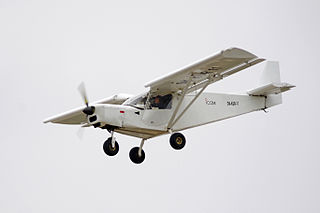
A short takeoff and landing (STOL) aircraft is a conventional fixed-wing aircraft that has short runway requirements for takeoff and landing. Many STOL-designed aircraft also feature various arrangements for use on airstrips with harsh conditions. STOL aircraft, including those used in scheduled passenger airline operations, have also been operated from STOLport airfields which feature short runways.
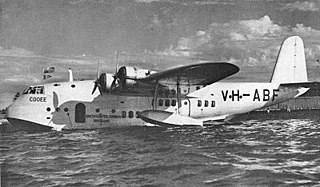
A flying boat is a fixed-winged seaplane with a hull, allowing it to land on water, that usually has no type of landing gear to allow operation on land. It differs from a floatplane as it uses a purpose-designed fuselage which can float, granting the aircraft buoyancy. Flying boats may be stabilized by under-wing floats or by wing-like projections from the fuselage.

A seaplane is a powered fixed-wing aircraft capable of taking off and landing (alighting) on water. Seaplanes are usually divided into two categories based on their technological characteristics: floatplanes and flying boats; the latter are generally far larger and can carry far more. Seaplanes that can also take off and land on airfields are in a subclass called amphibious aircraft, or amphibians. Seaplanes were sometimes called hydroplanes, but currently this term applies instead to motor-powered watercraft that use the technique of hydrodynamic lift to skim the surface of water when running at speed.

The Cessna 152 is an American two-seat, fixed-tricycle-gear, general aviation airplane, used primarily for flight training and personal use. It was based on the earlier Cessna 150 incorporating a number of minor design changes and a slightly more powerful engine with a longer time between overhaul.

An amphibious aircraft or amphibian is an aircraft that can take off and land on both solid ground and water. Fixed-wing amphibious aircraft are seaplanes that are equipped with retractable wheels, at the expense of extra weight and complexity, plus diminished range and fuel economy compared to planes designed for land or water only. Some amphibians are fitted with reinforced keels which act as skis, allowing them to land on snow or ice with their wheels up.
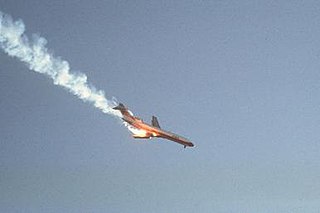
Pacific Southwest Airlines (PSA) Flight 182 was a Boeing 727-214 commercial airliner, registration N533PS, that collided with a private Cessna 172 light aircraft, registration N7711G, over San Diego, California, at 9:01 am on Monday, September 25, 1978. It was Pacific Southwest Airlines' first fatal accident, and the deadliest air disaster in California history.

The Cessna 208 Caravan is a utility aircraft produced by Cessna. The project was commenced on November 20, 1981, and the prototype first flew on December 9, 1982. The production model was certified by the FAA in October 1984 and its Cargomaster freighter variant was developed for FedEx. The 4 ft (1.2 m) longer 208B Super Cargomaster first flew in 1986 and was developed into the passenger 208B Grand Caravan.
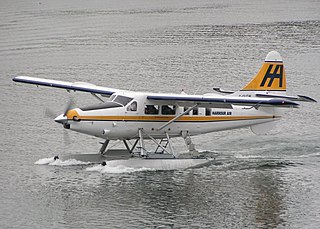
A floatplane is a type of seaplane with one or more slender floats mounted under the fuselage to provide buoyancy. By contrast, a flying boat uses its fuselage for buoyancy. Either type of seaplane may also have landing gear suitable for land, making the vehicle an amphibious aircraft. British usage is to call "floatplanes" "seaplanes" rather than use the term "seaplane" to refer to both floatplanes and flying boats.

The de Havilland Canada DHC-3 Otter is a single-engined, high-wing, propeller-driven, short take-off and landing (STOL) aircraft developed by de Havilland Canada. It was conceived to be capable of performing the same roles as the earlier and highly successful Beaver, including as a bush plane, but is overall a larger aircraft.
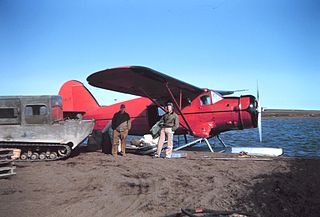
Bush flying refers to aircraft operations carried out in the bush. Bush flying involves operations in rough terrain where there are often no prepared landing strips or runways, frequently necessitating that bush planes be equipped with abnormally large tires, floats, skis or any other equipment necessary for unpaved runway operation. It is the only viable way of delivering people and supplies into more difficult to reach, remote locations.

The Cessna 205, 206, and 207, known primarily as the Stationair are a family of single-engined, general aviation aircraft with fixed landing gear, used in commercial air service as well as for personal use. The family was originally developed from the popular retractable-gear Cessna 210 and produced by the Cessna Aircraft Company.

The Cessna 190 and 195 Businessliner are a family of light single radial engine powered, conventional landing gear equipped, general aviation aircraft which were manufactured by Cessna between 1947 and 1954.

The Edo OSE was a 1940s American single-seat multi-role floatplane designed and manufactured by the Edo Aircraft Corporation.

EDO Aircraft Corporation was an American aircraft manufacturing company known primarily for manufacturing pontoons for floatplanes.

Seair Seaplanes is a scheduled and charter airline based in Richmond, British Columbia, Canada. The airline flies routes between the Vancouver International Water Airport and the Nanaimo Harbour Water Airport, as well as other Gulf Islands in the Strait of Georgia, primarily with float planes.

The Quest Kodiak is an American utility aircraft designed and built by Quest Aircraft. The high-wing, unpressurized, single-engined turboprop has a fixed tricycle landing gear and is suitable for STOL operations from unimproved airfields.

The Vought XSO2U was an American observation floatplane developed by Vought-Sikorsky for the United States Navy during the late 1930s. Intended to replace the Curtiss SOC Seagull in service as a scout aboard cruisers, it proved superior to the Curtiss SO3C in evaluation, but failed to win a production contract due to Vought's lack of manufacturing capacity.

Air Spray (1967) Ltd. trading as Air Spray Ltd. of Edmonton, Alberta, Canada and Air Spray USA Inc of Chico, California is a private company specializing in aerial wildfire suppression using air tanker or water bomber aircraft. Air Spray was owned and operated by Canada's Aviation Hall of Fame inductee, Donald T. Hamilton until his passing in 2011. The company continues to be owned and operated by his daughter, Lynn Hamilton, of Foothills, Alberta.
Dwane Leon Wallace was an American aviation businessman and aircraft designer. He served as the president and/or chairman of the board of the Cessna Aircraft Company from 1935 until the 1970s, having then continued on the board as a director and consultant into the 1980s. Wallace later became known as the "Quiet Giant of Aviation", and was posthumously inducted into the National Aviation Hall of Fame in 2012. He was included in the Flying Magazine list of the "51 Heroes of Aviation", placing at number 11.

Aircraft Radio Corporation (ARC) – not to be confused with Aeronautical Radio, Inc. (ARINC) – was a principal pioneer and major manufacturer of avionics for military and commercial aircraft, and later general aviation (light) aircraft, from the 1920s to the 1950s—subsequently acquired and rebranded by a succession of other companies, each of whom changed the official name, of the enterprise, while initially continuing ARC's primary function, staffing, facilities and product focus.
References
- ↑ 3M established its executive transport division in 1963 with a Wipaire aircraft. 3M COMPANY: An Inventory of Its Corporate Records at the Minnesota Historical Society (accessed February 12, 2013)
- 1 2 3 "Wipaire's History". www.wipaire.com. November 9, 2016. Retrieved May 8, 2017.
- ↑ The Cub float is the smallest unit available as of January 2013, but in an interview the President stated that his staff were developing units for light sport aircraft.
- ↑ "Wipaire names Chuck Wiplinger president". General Aviation News. January 24, 2011. Retrieved May 8, 2017.
- ↑ William Garvey, Making Waves - Afloat with flourish, and expanding Aviation Week & Space Technology, February 4, 2013 issue, p. 16
- ↑ Plane & Pilot, "Adding Oomph to a Modest Airplane" (March 24, 2015)
- ↑ Modifications for the Cessna 182. Wipaire "Boss 182", 2017
- ↑ "Products and Services by Aircraft | Wipaire, Inc". November 9, 2016.